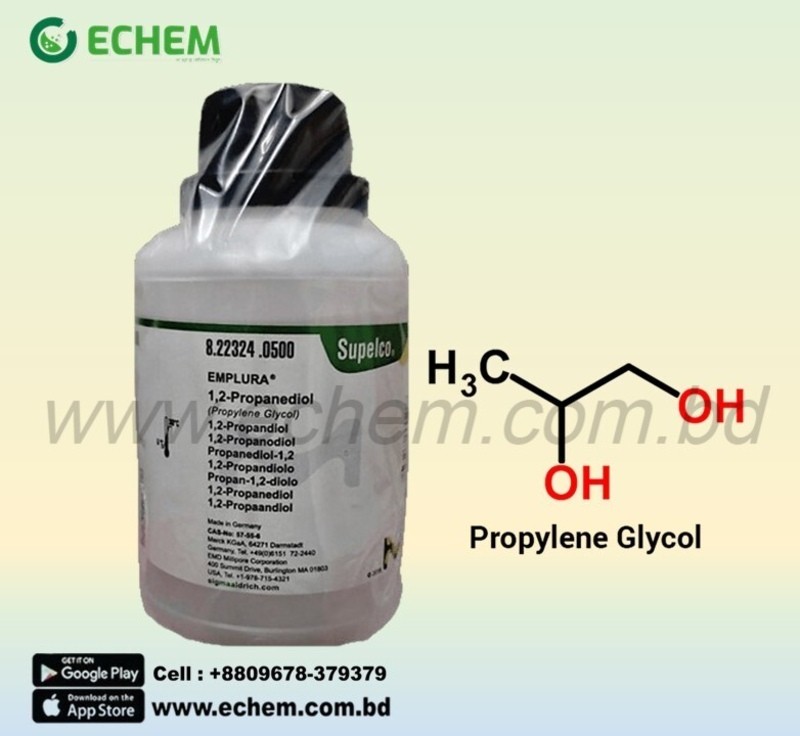
Price :
৳2300
Estimated Shipping Time: Deliveries take up to 3-5 days after you place your order.
Uses: Lab Essentials
Product SKU: FIt6566obp
Propylene Glycol (1,2-Propanediol) 500ml Merck, Germany
·
Propylene
Glycol (1,2-propanediol) is a viscous, colorless liquid that is nearly odorless
but has a faintly sweet taste.
·
Its chemical formula is CH3CH(OH)CH2OH.
It is miscible with various solvents, including water, acetone, and chloroform.
In general, glycols are non-irritating and have very low volatility.
·
It is produced on a large scale primarily
for the production of polymers. The European Union has E-number E1520 for food
applications. For cosmetics and pharmacology, the number is E490. Propylene
glycol is also present in propylene glycol alginate, which is known as E405.
Propylene glycol is approved and used as a vehicle for topical, oral, and some
intravenous pharmaceutical preparations in the U.S. and Europe.
Propylene Glycol (1,2-Propanediol) 500ml Merck, Germany
|
CAS # |
EC Number |
Hill Formula |
Chemical Formula |
Molar Mass |
|
57-55-6 |
200-338-0 |
C₃H₈O₂ |
CH₃CH(OH)CH₂OH |
76.09 g/mol |
|
Catalogue Number |
822324 |
|
Synonyms |
1,2-Propylene
glycol |
|
Description |
1,2-Propanediol |
|
Overview |
EMPLURA® is
our low-cost alternative to high-purity qualities. With EMPLURA® we
offer a range of solvents for a plurality of basic applications in
non-regulated industries and for less demanding applications, preparative
laboratory work and cleaning purposes. EMPLURA® solvents
provide adequate specifications with the most important parameters. |
|
CAS number |
57-55-6 |
|
EC number |
200-338-0 |
|
Hill Formula |
C₃H₈O₂ |
|
Chemical formula |
CH₃CH(OH)CH₂OH |
|
Molar Mass |
76.09 g/mol |
|
HS Code |
2905 32 00 |
|
Quality Level |
|
|
Boiling point |
188 °C (1013 hPa) |
|
Density |
1.036 g/cm3
(25 °C) |
|
Explosion limit |
2.4 - 17.4 %(V) |
|
Flash point |
99 °C |
|
Ignition temperature |
371 °C |
|
Melting Point |
-59 °C |
|
pH value |
6 - 8 (100 g/l, H₂O, 20 °C) |
|
Vapor pressure |
0.2 hPa
(25 °C) |
|
Refractive Index |
1.43 (20 °C) |
|
LD 50 oral |
LD50 Rat 19400 - 36000 mg/kg |
|
LD 50 dermal |
LD50 Rabbit
20800 mg/kg |
|
RTECS |
TY2000000 |
|
Storage class |
10 - 13 Other
liquids and solids |
|
WGK |
WGK 1 slightly hazardous to water |
|
Disposal |
3 |
|
Storage |
Store at +5°C to +30°C. |
|
Purity (GC) |
≥ 99.0 % |
|
Identity (IR) |
conforms |
|
Density (d 20 °C/ 4 °C) |
1.036 - 1.037 |
|
Water |
≤ 0.20 % |
|
Global Trade Item Number |
|
|
Catalogue Number |
GTIN |
|
8223241000 |
04022536489209 |
|
8223245000 |
04022536489216 |
No Review Found.
Login To Comment